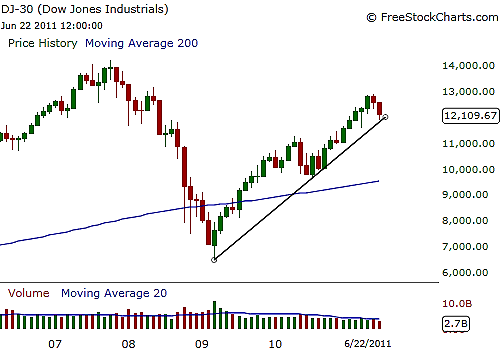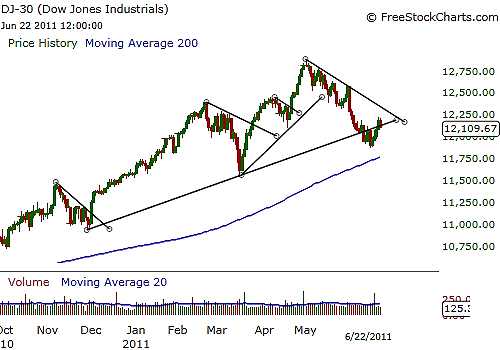
HOT TOPICS LIST
- MACD
- Fibonacci
- RSI
- Gann
- ADXR
- Stochastics
- Volume
- Triangles
- Futures
- Cycles
- Volatility
- ZIGZAG
- MESA
- Retracement
- Aroon
INDICATORS LIST
LIST OF TOPICS
PRINT THIS ARTICLE
by Billy Williams
The Dow Jones Industrial Average offers exciting opportunities for traders, but only if you understand the three types of trends that are common to this market.
Position: Hold
Billy Williams
Billy Williams has been trading the markets for 27 years, specializing in momentum trading with stocks and options.
PRINT THIS ARTICLE
STRATEGIES
Dow Trading Strategies, Three Types Of Trends To Trade
07/08/11 09:01:34 AMby Billy Williams
The Dow Jones Industrial Average offers exciting opportunities for traders, but only if you understand the three types of trends that are common to this market.
Position: Hold
| The Dow Jones Industrial Average (DJIA) has become more popular because of its high liquidity and fast-moving price action. The addition of the emini Dow, a smaller-sized futures contract that is a tenth the size of the regular Dow futures contract, has helped to increase the popularity of the Dow amid traders. The DJIA, an index made up of 30 publicly traded US companies across a diversified segment of the US business landscape, is one of the "Big Three" indexes that are watched by traders worldwide, the other two being the Standard & Poor's 500 and NASDAQ. While traders are attracted to the opportunities in the DJIA, they lack an understanding of the types of trends that take place in that market. They don't really understand how its price action develops and do not have a proper trading strategy to take advantage of how the DJIA trades in order to profit on a consistent basis. See Figure 1. |

|
| FIGURE 1: DJIA. Using a five-year price chart of the Dow Jones industrials, you can see from the bullish trendline that the DJIA is in a primary uptrend and sets the stage for trading in this direction on the smaller time frames. |
| Graphic provided by: www.freestockcharts.com. |
| |
| Charles Henry Dow, the creator of the DJIA as well as Dow theory, identifies three types of trends -- long term, intermediate term, and short term -- that are present at any given time that could help you time the market by being able to identify the trend that is currently trading in the present. See Figure 2. |

|
| FIGURE 2: DJIA. On the intermediate time frame, you can use a combination of trendlines that shows you the bullish path the DJIA is moving toward. By using bearish trendlines on the short-term trend during pullbacks, you can time your entries when price resumes its upward path in the direction of the primary long-term trend. |
| Graphic provided by: www.freestockcharts.com. |
| |
| The long-term trend forms over a period of months to over a course of years; this trend is the most powerful trend out of the three and will often be the primary trend that you want to trade in the direction of. The long-term trend is the preferred time frame for large mutual funds or buy & hold investors in the stock market, but mini-Dow traders can take advantage of long-term trends the same way by using the smaller time frames to identify the ideal entry point and then sound risk control to ride the trend's momentum in a direction that is favorable to your position. |
| The intermediate-term time frame spans from a matter of weeks to months, up to about a year. This is the preferred time period for swing stock traders and option traders but is also ideal for trading the DJIA. The DJIA has a lot of price movement within the intermediate time frame and using reliable swing trading techniques, like pullback trading, you can enter as price pulls back slightly and latch onto this trend. |
| Short-term trends take place from as little as a minute up to a week, which is the time frame that daytraders commonly trade. Daytraders trade the Dow Jones index futures because they can move in and out of the futures market easily and because their trading strategy lets them rack several winning positions during the day without having to hold a position overnight. However, be aware that the DJIA can be traded 24 hours a day, but the price action is sluggish after the final bell of the day's trading period due to a lack of trade volume. Knowing the time frames that each of these trends operate in can help you stay on the right side of the market by knowing which trend is in play. Larger time frames will have more power over the smaller times frames so if you trade short-term trends, as an example, be sure to be aware of what direction the intermediate trend is in and use the short-term time frame for entries that are in sync with its direction. By keeping your trades in tandem with the larger trends that are under way, you can potentially make more successful trades and reduce your losses. |
Billy Williams has been trading the markets for 27 years, specializing in momentum trading with stocks and options.
| Company: | StockOptionSystem.com |
| E-mail address: | stockoptionsystem.com@gmail.com |
Traders' Resource Links | |
| StockOptionSystem.com has not added any product or service information to TRADERS' RESOURCE. | |
Click here for more information about our publications!
PRINT THIS ARTICLE

|

Request Information From Our Sponsors
- VectorVest, Inc.
- Executive Premier Workshop
- One-Day Options Course
- OptionsPro
- Retirement Income Workshop
- Sure-Fire Trading Systems (VectorVest, Inc.)
- Trading as a Business Workshop
- VectorVest 7 EOD
- VectorVest 7 RealTime/IntraDay
- VectorVest AutoTester
- VectorVest Educational Services
- VectorVest OnLine
- VectorVest Options Analyzer
- VectorVest ProGraphics v6.0
- VectorVest ProTrader 7
- VectorVest RealTime Derby Tool
- VectorVest Simulator
- VectorVest Variator
- VectorVest Watchdog
- StockCharts.com, Inc.
- Candle Patterns
- Candlestick Charting Explained
- Intermarket Technical Analysis
- John Murphy on Chart Analysis
- John Murphy's Chart Pattern Recognition
- John Murphy's Market Message
- MurphyExplainsMarketAnalysis-Intermarket Analysis
- MurphyExplainsMarketAnalysis-Visual Analysis
- StockCharts.com
- Technical Analysis of the Financial Markets
- The Visual Investor
